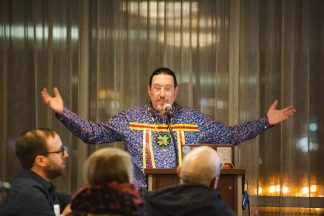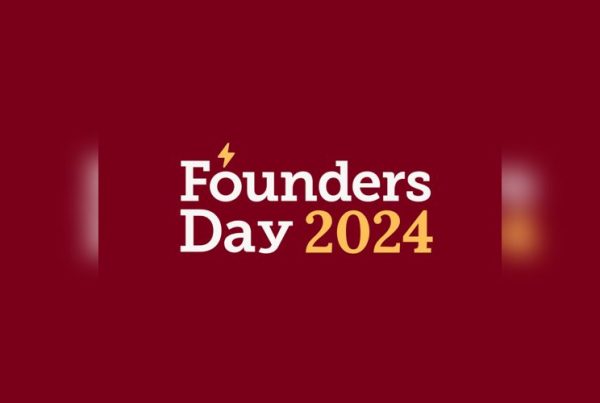By Allison Campbell-Jensen
While working for the U.S. Forest Service, Michael Dockry taught colleagues, one at a time, about the benefits of building relationships with indigenous people — that it makes sense to take advantage of the wisdom of those who have lived on these lands for generations.
At the annual “A Feast of Words” event, held Jan. 26 at the Campus Club, Dockry — wearing a traditional ribbon shirt — said that he came to the University of Minnesota in 2019 so that he could share his experiences and his research more broadly, with hundreds of young people who will work in forestry.
With a stronger foundation of building partnerships that last, these foresters and those in the natural resources departments of native nations with whom they work can benefit the generations to come.
“A lot of my profession is planning — getting people together to talk about our issues,” said Dockry, an assistant professor of tribal resource management in the University’s College of Food, Agricultural, and Natural Resource Sciences. If we can better plan for the future, “we can walk forward in unison.”
He added: “We can all admit we are in an unsustainable situation now.”
A Feast of Words is an annual event sponsored by the Friends of the University Libraries and the Campus Club.
Building connections
Along with teaching and research, Dockry is working with the Kawe Gidaa-naanaagadawendaamin Manoomin (Manoomin is an Ojibwe word for wild rice) — a joint Tribal-University Research Collaboration examining the decline in wild rice. The partnership involves tribal nations, intertribal treaty organizations, and the University of Minnesota.
Indigenous people are leading the way. For the different agencies of federal, state, county, and indigenous nations’ governments to work well together, however, he says they need to pay attention to principles for strategic partnerships.
- Acknowledge past and present harms;
- Collaborate as equals;
- Create formal agreements that outlast individuals; and,
- Foster personal relationships.
Among the past and present harms to be acknowledged is the U of M’s focus on cultivating wild rice. Public historian Chris Rico, who trained at the University of Minnesota and was in the audience, spent years in the University Archives tracing the evidence of this seemingly well-intentioned research by U of M scientists.
Presenting the scientists’ point of view, Dockry said: “It could be more efficient.”
But to the nations who came to the Upper Midwest because of wild rice, the Anishinabe (Ojibwe) peoples, wild rice is not only food; wild rice is a spiritual relative, a sovereign being. Some tribes with this family relationship say to scientists: “You have no right to do that,” to breed a type of wild rice that provides larger harvests.
That sort of research, Dockry added, is not being done to support wild rice. As a parallel, Dockry said: “Nobody would change Grandma so that she would cook soup for 15 hours a day.” The tribes are showing us how to lead: “If Grandma’s sick, let’s have a family discussion.”
And one of the ways to build trust for that family discussion is to build connections.
“We have to canoe the waters together; we have to walk the lands together,” Dockry said.
Indigenous wisdom
“[A]ll lands in the United States were tribal lands. For generations after generations, we’ve been managing them.”
— Michael Dockry
Wilderness is a myth dreamed up and inculcated by the colonial settlers. Land “untrammeled by Man” does not and did not exist in North America, Dockry says. Today, there are 574 federally recognized tribes who formerly (and currently) steward the lands, waters, and forests. The tribes who were photographed at the beginning of the 20th century by Smithsonian ethnographers to capture their ways “before they vanished”? They have not vanished.
“We are still here,” Dockry says. Despite removals of most of the peoples from their original territories to reservations in remote areas, “all lands in the United States were tribal lands. For generations after generations, we’ve been managing them.”
In what is now Wisconsin, the Menominee Tribe have always been living in what is now Northeast Wisconsin. Their lands have been managed according to the formula advanced by Chief Oshkosh in the 19th century and rights solidified by treaty with the U.S. government.
More than 100 years later, in contemporary satellite images, the Menominee reservation stands out as a green, forested space in an otherwise patchworked landscape.
Their successful forest management, which benefits the local economy as well as the ecology, is just one example of how indigenous people can help all of us address the challenges we face in the 21st century, from social changes to climate change.
After land management by native peoples, original prairie plants returned. “Big Bluestem came back after these burns,” Dockry said. “The soil has memory.” As do the indigenous peoples of what is now North America.
Podcast (friends): Play in new window | Download





